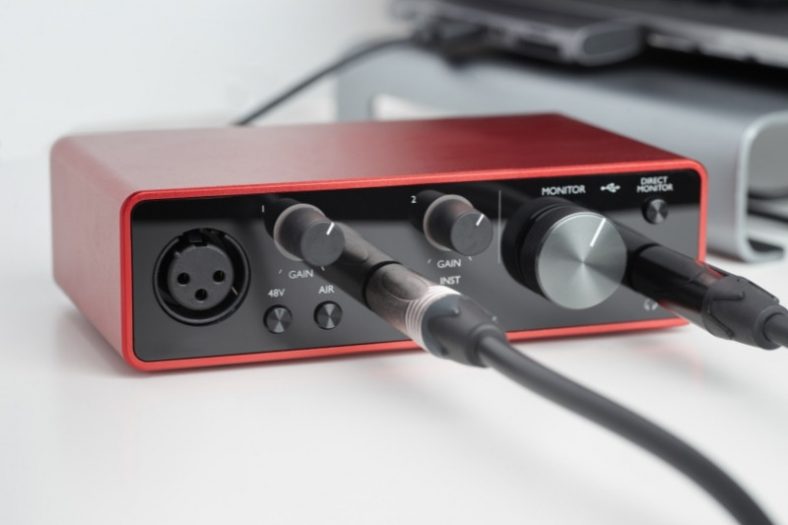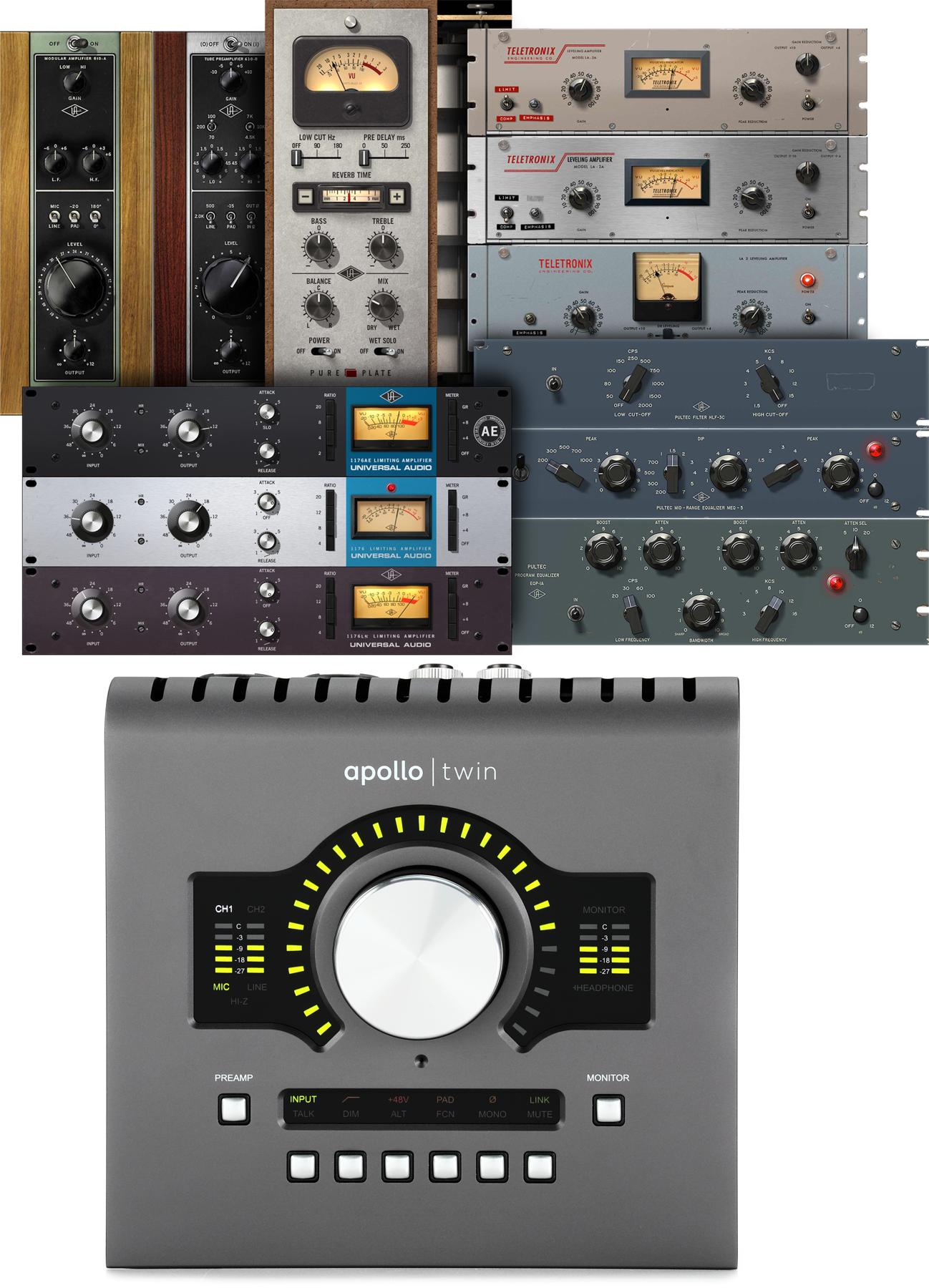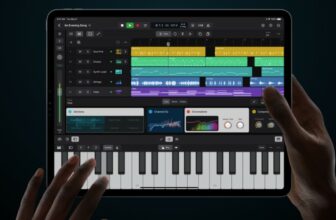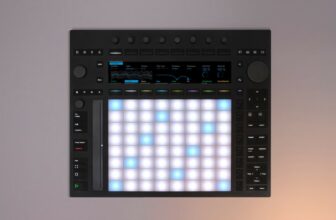What Is An Audio Interface and Do You Need One?

Audio interfaces are one of the most essential tools for audio production, especially if you’re making music at home. Nowadays, a laptop, a microphone, and an audio interface are all you need to recreate an expensive analog studio inside your bedroom.
But what are audio interfaces exactly, and what are they used for?
Contents
- What is an audio interface?
- What is the purpose of an audio interface?
- How to use an audio interface?
- Do you need an audio interface if you have a USB mic?
- Choosing the right interface
- How many inputs and outputs do you need?
- Types of audio interfaces
- Choosing an audio interface with quality drivers
- Can you record on a budget audio interface?
- Is a sound card the same as an audio interface?
- Summary
What is an audio interface?
An audio interface is a piece of hardware used to convert sound signals into digital audio, enhance audio recordings, and route audio from your computer to your headphones and speakers.
Audio interfaces offer all the features of traditional analog recording equipment (depending on the model), but they do so in a digital-audio setup.
If you’re making music on your computer, audio interfaces are a must-have: they’re extremely convenient for recording and improving the quality and reliability of your sound system.
What is the purpose of an audio interface?
The purpose of an audio interface is to record and process sound via a computer.
Their main function is to convert sound signals into digital data, but they’re often viewed as a convenient tool for recording and monitoring audio through the computer.
In the home studio era, audio interfaces are the bread-and-butter of any music producer’s setup. They enhance sound quality, they’re perfect for recording audio to your favorite DAW or music software, and they can be used as the point of connection between your computer and a set of high-quality speakers or studio monitors.
How to use an audio interface?
Connect the audio interface to your computer, install the corresponding sound drivers (check the box for a download link if necessary), and select the appropriate driver in your DAW’s settings. Connect the audio interface’s output to a set of speakers or studio monitors, and you’re ready to go!
To use an audio interface for recording, look for the microphone and line inputs (line-ins are often placed in the back of the interface). Connect your microphone or instrument to the correct input and use the gain knob to drive the sound up. Finally, hit ‘record’ on your DAW of choice and tweak the sound according to taste.
If you’re using a condenser microphone, don’t forget to turn your audio interface’s phantom power on (phantom power is typically represented by a small button next to the mic-ins).
For more information about the different aspects of recording using the inputs of an audio interface, please check this line-level differences article.
Do you need an audio interface if you have a USB mic?
If you have a USB microphone, you can record audio into your computer without an audio interface, as USB mics can convert sound signals into digital data.
For this reason, you can use a USB mic as a standalone piece of recording equipment even if you don’t own an audio interface.
Not having to buy an audio interface to record digital audio is the biggest plus of having a USB mic, but keep in mind the overall quality of your USB mic’s recordings can be below-par. That’s why you will most likely never find a USB microphone in a professional recording studio.
While convenient, USB mics are still not nearly as good as traditional analog microphones, even if you opt for an expensive model. However, talented music producers can still achieve excellent results using a USB mic.
Choosing the right interface
Audio interfaces can go from very affordable to super expensive, but they all serve the same basic purpose: to allow you to record and process sound via a computer. This said, selecting the right interface is about understanding your needs as a music producer.
Are you a guitar-and-vocals singer-songwriter trying to make a demo in your bedroom? In this case, a basic audio interface with two mic-ins should be enough. Are you an audio engineer trying to make a living by recording bands in a professional studio? Then you should probably get yourself a high-quality audio interface with at least eight inputs.
My point is that you should first understand what your goals and needs as a musician are, and only then pick the audio interface that suits you better.
These three highly recommended audio interfaces should give you an idea of what’s out there:
The Focusrite Scarlett 2i2 (4th gen) has become a standard product in the audio interface world, especially since the 3rd gen was so popular. Perfect for beginners and home-studio musicians, the Focusrite Scarlett 2i2 works as the ideal introduction to the world of audio recording.
The Focusrite Scarlett 2i2 (4th gen) is a market leader because it offers good drivers, ultra-low-noise mic preamps, and all the essential features of an audio interface at a cost everybody can afford.
If the Focusrite Scarlett 2i2 (4th gen) is the number-one audio interface for newbies, the Apollo Twin MKII is the professional-studio standard. It’s pricey without going over the top and is developed by the renowned engineers of Universal Audio, arguably the most reputable audio signal processing hardware company in the world.
Two things make Apollo Twin MKII a one-of-a-kind audio interface: its zero-latency mixing console (which works fine even in low-processing computers), and its exclusive state-of-the-art audio plugins.
If you’re working with a live band, or you feel the need to record multiple instruments simultaneously, you should give MOTU 16A AVB a try. This audio interface is only expensive if you choose to ignore the fact it includes 16 inputs, 16 outputs, and both Thunderbolt and USB connectivity.
The MOTU 16A AVB is not the ultimate 16-input audio interface in the market, but it’s probably the one that offers the best quality-price ratio.
How many inputs and outputs do you need?
To answer this question, consider your recording process. Are you a solo musician, recording one instrument at a time? Or do you like to get your friends together in a room and record everybody playing simultaneously? The number of inputs you require is directly related to your recording style.
In my experience, two inputs tend to be more than enough if you’re an electronic music producer working with vocals and adding occasional acoustic instruments to your songs. For a live band setup, you should need a minimum of four to eight inputs.
The same goes for the outputs. Two balanced line-outs should be enough unless you want to split the sound into multiple channels.
Types of audio interfaces
USB audio interfaces are by far the most common, but there are at least four types of audio interfaces: USB, Thunderbolt, FireWire, and PCIe. Before selecting your next audio interface, don’t forget to check the available ports on your computer.
USB
Virtually all computers come with a USB port, which helps to make USB audio interfaces the most popular option in the market. Another plus is that USB audio interfaces rarely require an external power supply.
Thunderbolt
Perfect for Mac users, Thunderbolt audio interfaces stand out because of their speed and low latency, which is ideal for recording multiple instruments at the same time.
FireWire
Relatively outdated, FireWire audio interfaces transfer data at a more consistent rate than USB interfaces, which is a plus if you’re going for reliability.
PCIe
PCIe audio interfaces need to be installed into your computer’s motherboard, as PCIe is an internal card-based interface. For this reason, PCIe audio interfaces aren’t great for laptop users.
Choosing an audio interface with quality drivers
The drivers of your audio interface will help to define the sound quality of your recordings. Normally, more expensive audio interfaces feature better drivers, meaning that the signals captured by microphones will be more accurately amplified. Top-of-the-market drivers have a distinctive quality, characterized by an audible sound definition and warmth.
However, the price tag shouldn’t be the ultimate metric for evaluating the quality of an audio interface’s drivers. Audient iD4, for instance, makes for a very affordable audio interface but features the same state-of-the-art drivers that power Audient’s top-of-the-line mixing consoles.
Can you record on a budget audio interface?
With enough talent and hard work, you can come up with a number-one song using even the most basic of audio interfaces.
Recording equipment makes a big difference, but it’s not what makes a song great. Sure, Bruno Mars’ voice sounds a lot better when he’s singing with his award-winning Sennheiser SKM5200 microphone. But would he be any less talented if he recorded his songs using an iPhone?
In the end, good and bad music is defined by a musician’s prowess, not by the tools he or she owns.
Is a sound card the same as an audio interface?
Both sound cards and audio interfaces are used to convert signals into digital audio data. However, they’re very distinctive because sound cards tend to be installed in a computer’s motherboard beforehand, while audio interfaces work as add-on external sound cards.
To put it simply, think of sound cards as integrated circuits installed inside your computer and of audio interfaces as a piece of hardware that contains not only a sound card but a series of additional features.
For further clarification, please take a look at this article on sound cards, onboard audio, and audio interfaces.
Summary
So, do you need an audio interface? If you’re making music at home, I would highly recommend it. You can do a lot with even the most basic of audio interfaces and take your songs and demos to the next level.
Audio interfaces make for the perfect point of connection between you—the artist—and your computer—the platform in which your art is ultimately produced. Getting an audio interface will inspire you to put more of yourself into your music.








